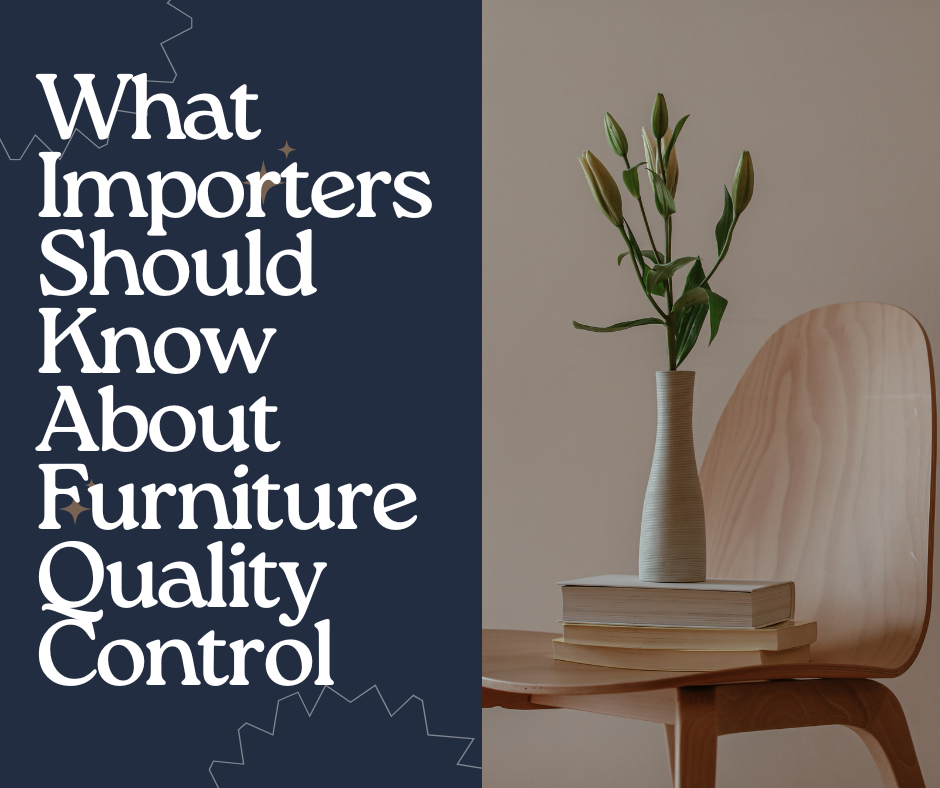
QUALITY CONTROL
Furnishings are essential components of a home that reflect individual style and design. Retailers and online shops face difficulties in maintaining uniqueness and creativity while adhering to consumer safety and meeting time-to-market demands when it comes to furniture production in Asia and China. Streamlining their supply chains is critical in achieving these goals. Moreover, quality control plays a crucial role in the furniture manufacturing process. As furniture production shifts to less expensive manufacturing nations, the demand for dependable and proficient furniture inspection has become more important than ever.
Understanding the Various Categories of Furniture Defects
For importers, purchasing furniture from manufacturers in Southeast Asia can be a challenging experience due to logistical, compliance, and communication obstacles that may pose risks.
To expedite and clarify the furniture inspection report, it is essential to define the defect categories at the outset of the import process:
Critical defect – a defect that creates hazardous and unsafe conditions for users and can impact the performance of the item. A critical defect can include one or more defects. Major defect – a defect that is likely to cause failure or reduce the product’s usability. Minor defect – a defect that has little impact on the product’s effectiveness or operation and is unlikely to reduce its usability.”
Inspection Solutions Conducting a root cause analysis can help you address any defective furniture products with your supplier. The process involves:
- Recognizing and defining the problem: Acknowledge and describe the production problem.
- Identifying the causes: Identify the root causes of the problem.
- Identifying solutions: Determine the best possible solutions based on cause identification to address the problem.
- Implementing the solutions: Optimize and improve operational processes through the chosen solution.
To identify and resolve issues with potential furniture suppliers, HQTS offers the following solutions:
During Production Inspection (DPI):
Inspection during production is a critical step that ensures your furniture meets the expected quality level and is ready for immediate shipment. The inspection evaluates production status and quality controls implemented on the production line, identifying defects as early as possible. Inspection reports should include all quality issues, no matter how minor.
After receiving the DPI report, review the product specification lists and fix any items with a ‘pending’ status.
Pre-Shipment Inspection (PSI):
A random furniture sample is selected for inspection to identify any visual defects and ensure the product meets production specifications. With the complex supply chain process and the risk of product recalls and returns, importers need to ensure that the products meet consumer expectations and comply with global regulations and safety and quality standards. Conducting a factory inspection reduces the likelihood of defects and ensures worker and inspector safety.”
An expert furniture inspection offers numerous benefits to ensure that furniture products meet quality and safety standards.
By visually inspecting furniture products against CAD design sketches and samples, inspectors can check for aesthetic compliance and identify any visual imperfections such as defects related to dimensions, discolouration, finishing, scratches, warping, and other imperfections. On-site checks and tests are also necessary to ensure structural safety through load tests, impact tests, arm and leg strength tests, and other relevant stability tests.
Another benefit of furniture inspection is ensuring compliance with legal standards related to illegal logging, wrong labelling of filling materials, and the illegal use of textile fibres for upholstered products. Additionally, packaging inspections are conducted to check for appropriate packaging of the furniture parts to protect against abrasion and climate impacts, preventing damage during shipping.
Lab tests,
Including flammability and fire resistance testing, chemical testing for lead content in surface coatings, and pentachlorophenol and formaldehyde in composited wood products, are also conducted to ensure furniture products meet safety and regulatory standards.
A detailed furniture inspection report is an essential part of the process, including inspection information, reference photos, inspection standards, inspection results, overall conclusions, remark points, quantity status, appearance/functionality, product style and colour, data measurement, packing method, and additional information.
During the inspection, inspectors ask a series of questions to fully understand the full history of the problem to compile an accurate final report. A furniture inspection checklist includes checks for appearance, metal detection, zipper, smell, labelling/marking, assembly, stability, loading, size measurement, barcode readability, tape and rub, moisture content, sofa bottom spring and frame, cushion stuffing, carton drop test, carton size and weight, and quantity per carton.
Inspectors closely inspect the furniture looking at many key areas for structural points and potential weaknesses in the frame. Suspension systems are inspected, types of springing systems noted, and possible improvements pointed out. The fillings of cushions and casings are fully checked for sectional failures or possible faulty batches. Fabric finish, type, and wear qualities are also inspected, checking for running faults, uneven wear paths, and correct pile/shading direction.
Using a neutral third-party quality provider with expertise in inspection and sourcing can help overcome communication and language barriers when sourcing furniture across Asia. This can ensure that product specifications are communicated correctly and clearly, resulting in the best top-quality products for consumers.
Auditing Furniture Factories
Supplier audits and furniture factory audits provide a comprehensive analysis of a supplier’s strengths, weaknesses, and condition. This service helps factories identify areas that require improvement to better meet the needs of importers.
The standard factory audit covers various aspects, including the manufacturer’s background, workforce, production capacity, equipment, manufacturing process, in-house quality system, management system, and environmental impact.
Testing Lab Furniture
It’s crucial to conduct independent furniture testing before shipping goods to clients to ensure any issues are addressed at an early stage, saving time and costs. At HQTS, we employ different methods to inspect and test your furniture, ensuring top-quality testing approach.
We test for formaldehyde using the chamber method, flask method, and perforator method for wood panel and finishing products. For wood-based panels and surface decoration, we use the walk-in chamber reference, flask method, and perforator method. For indoor-based furniture, we use the flask method. We also test for PCP, CU, CR, AS wood preservatives, and soluble lead, cadmium, chromium, and mercury in paint on furniture.
Furniture Quality Standards
When it comes to furniture quality standards, it’s crucial to consider internationally recognized standards that can be verified through inspections and testing. This helps ensure that your products can withstand various elements, including sun, rain, snow, and wind.
ASTM F1561-03
The International Association for Testing Materials (ASTM) American Section develops international standards for manufacturing and testing products. ASTM F1561-03 assesses the performance requirements for outdoor plastic chairs used in both residential and non-residential settings.
Europe
In Europe, 49% of furniture recalls involve outdoor products. The European Committee for Standardisation (CEN) has developed a set of standards to address all safety requirements for outdoor furniture.
EN 581-1 provides the general safety requirements for outdoor furniture. EN 581-2 specifies the mechanical test methods to establish safety for outdoor seating furniture. EN 581-3 provides mechanical testing procedures for outdoor tables. EN 581-4 determines durability testing of outdoor furniture when exposed to environmental factors such as rain.
EN 581-3
EN 581-3 was updated in January 2017 to provide greater clarity for various table types, including tables with and without extensions, longer and smaller tables. The revised version also includes demands for glass table-tops to ensure parasol holes are protected, preventing metal-to-glass contact.
AFNOR NF D60-300
The French Standardisation Association (AFNOR) develops safety standards applied in France and globally. AFNOR NF D60-300 provides safety requirements and test procedures for outdoor seating and tables for children.
UL 962
Underwriters Laboratories (UL) is an independent global supply safety solutions company. UL 962 creates an international safety standard applied to household and commercial furnishings, including outdoor furniture.
Inspections of furniture play a crucial role in reducing risks,
Improving quality, and managing the quantity of raw materials used in the manufacturing process. During an inspection, several aspects of the furniture should be evaluated, such as assembly, finish, color, design, packaging, labeling, and marking.
Furniture must comply with the correct quality, safety, and durability requirements. A thorough inspection process ensures that products are checked against all specifications to meet the customer’s specific needs. Corrections can be made and implemented before completion, reducing the risk of production failure and verifying the material, manufacturing, and finishing quality. Ultimately, this reduces the risk of after-sale services due to production defects.
Importers can significantly benefit from a high-quality inspection process by engaging an independent third-party inspector. This inspector will ensure that the process is tailored to the importer’s specific requirements, completed efficiently and promptly, and provide constant support throughout the inspection process.
IF YOU WANT EVERYTHING TO BE EASIER,. JUST CONTACT US FOR HAVE GOOD QUALITY AND BEST PRICE PRODUCT
